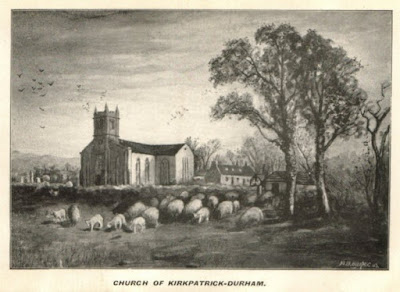1488: The Kilquhanity Lands: A Potted History
The Book of Kirk-Patrick Durham
In 1903 the Reverend William Stark wrote The Book of Kirkpatrick-Durham, in which he mentions, among other things, that the lands of the Parish of Kirkpatrick-Durham, once belonged to the M’Naight of the Kilquonadie family.
(1903)
I am guessing, but I think that Stark's main source of information may have come from a late 17th century Minister of Kirkinner, Andrew Symson, who wrote a book called A Description of Galloway which had been published in 1684.
And it is from Stark that we learn that “Kilquonadie” which translates from the Gaelic as the Cell of Kennedy, is an older version of the modern Kilquhanity and that Culconnady, the oldest form of the word, first appeared in the late 15th century.
In one of the chapters in his book Stark attempts to trace the history of the area known as Kilquhanity which forms part of the parish of the village of Kirkpatick-Durham.
It is not an easy read and in any case the chapter is far more concerned with the genealogy of the M’Naight family – which incidentally can apparently be spelt variously as MacNaight, M’Naught or Macknaicht, than trying to explain why the farmland on which the 19th century house was eventually built and came to be called Kilquhanity House School.
(1903)
By 1488 the Durhams had disappeared and the owner of Kilquhanity was Fergus M’Naught. The family members retained possession of most of their lands over the next 200 years. In 1542, however, one of them, a John M’Naught, was accused of a murder that took place in "the Parish or Urr". According to Stark, he more or less got away with it:
There is a local tradition that as a punishment for this murder John M’Naught was compelled to build the Old Bridge of Urr.
In 1612, a second murder. Another member of the family also called John M’Naught was set upon and killled in Carlingwark. He left a widow called Marion who later remarried William Fullerton Provost of Kirkcudbright. Of her three children, one of them, Roger, inherited the Kilquhanity. Marion was apparently responsible for composing the following acrostic in which the family surname appears with perhaps its most awkward spelling.
Acrostic upon the Name of that Very Religious and Famous Gentlewoman,
Marion M’Knaight (sic)
M More happy than imagine can beA And blessed are such as with heart sincereR Receive to cleave to Christ, to live and dieI In Him, with Him, and for Him to appearO Oh what transcendent glory grows from graceN none but, no not the soul refined, shallM’ Make to appear the light, that life, that peace,K Known only to the pure possessors all,N Now thou by grace art unto glory goneA and gained the garland of eternal blesseI In seeing Him who on the glorious throneC Created uncreated glory is:H Heaven’s quire did sing at thy conversions sweet,T Time past’s thy final comforts to compleat.
Roger was succeeded by his cousin John who died in 1646 and was succeeded by yet another John. His son Patrick emigrated to America and when he died in 1680, the M’Naught family became extinct. From now on the estate became the property of different individuals, some of them vaguely related to the M’Naughts, others not at all.
By 1744, however, the land had been divided into Nether and Upper Kilquhanity. The Nether bit soon became the property of George Gordon but it is the Upper area bought by James Gardner that interests us. It is here that Kilquhanity House School would eventually make its appearance.
From 1745 onwards, Upper Kilquhanity was resold more than once and by the early 18th century became the property of Robert Willliam Fergusson. The first house on the property, which originally had an L-shaped wing, was built c1810/1820, possibly by Robert as he still owned the Upper Kilquhanity land in 1845. He may have employed a local architect Walter Newall to do the job but it was one of his descendants, John Ferguson, who commissioned the extension to the main building to its current design. Walter Newall was also responsible for this work
By 1886 the population of Kirkpatrick, including Kilquhanity, had risen to well over a thousand and boasted at least 13 mansions, one of which was Fergusson’s home in Upper Kilquhanity.











